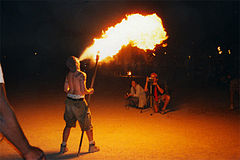User:SpencerHunt/Carnyville
| This is not a Wikipedia article: It is an individual user's work-in-progress page, and may be incomplete and/or unreliable. For guidance on developing this draft, see Wikipedia:So you made a userspace draft. Find sources: Google (books · news · scholar · free images · WP refs) · FENS · JSTOR · TWL |
Carnyville new article content ...
| Circus | |
|---|---|
 Advertisement for the Barnum & Bailey Circus, 1900. | |
| Types | Contemporary circus |
| Ancestor arts | Drama |
| Originating culture | Ancient Rome |
| Part of a series on |
| Performing arts |
|---|
A circus is commonly a travelling company of performers that may include
History
Red Bull took many marketing and ingredient ideas from an energy drink in Thailand called Krating Daeng. Dietrich Mateschitz, an Austrian entrepreneur, developed the Red Bull Energy Drink brand. Mateschitz was the international marketing director for Blendax, a toothpaste company, when he visited Thailand in 1982 and discovered that Krating Daeng helped to cure his jet lag.[1] Between 1984 and 1987, Mateschitz worked with TCBG Pharmaceutical (a Blendax licensee) to adapt Krating Daeng for the European market.
Origin
In Ancient Rome, the circus was a building for the exhibition of horse and chariot races, equestrian shows, staged battles, displays featuring trained animals, jugglers and acrobats. The circus of Rome is thought to have been influenced by the Greeks, with chariot racing and the exhibition of animals as traditional attractions. The Roman circus consisted of tiers of seats running parallel with the sides of the course, and forming a crescent around one of the ends. The lower seats were reserved for persons of rank; there were also various state boxes, e.g. for the giver of the games and his friends. In Ancient Rome the circus was the only public spectacle at which men and women were not separated.
Development

The modern concept of a circus as a circular arena surrounded by tiers of seats, for the exhibition of equestrian, acrobatic and other performances seems to have existed since the late 18th century.[2] The popularity of the circus in England may be traced to that held by Philip Astley in London.
Performance

A traditional circus performance is often led by a
Acts
Common acts include a variety of
.Musical acts

A variety of animals have historically been used in acts. While the types of animals used vary from circus to circus,
Animal acts

A variety of animals have historically been used in acts. While the types of animals used vary from circus to circus,
In music, films, plays, and books
The atmosphere of the circus has served as a dramatic setting for many musicians. The famous circus theme song is actually called "Entrance of the Gladiators", and was composed in 1904 by Julius Fučík. Other circus music includes "El Caballero", "Quality Plus", "Sunnyland Waltzes", "The Storming of El Caney", "Pahjamah", "Bull Trombone", "Big Time Boogie", "Royal Bridesmaid March", "The Baby Elephant Walk", "Liberty Bell March", "Java", Strauss's "Radetsky March", and "Pageant of Progress".
The film Tromba, about a tiger trainer was released in 1948 and in 1952
Etymology
First attested in English 14th century, the word circus derives from Latin "circus",[3] which is the romanization of the Greek "κίρκος" (kirkos), itself a metathesis of the Homeric Greek "κρίκος" (krikos), meaning "circle" or "ring".[4]
See also

- Acrobatics
- Aerobatics
- Animal training
- Chautauqua, tent shows that preceded American circus
- Circus clown
- Circus skills
- Cirque du Soleil
- Clown
- Contemporary circus
- Dog and pony show
- List of circuses and circus owners
Events
References
- ^ "Face value | Selling energy". Economist.com. 2002-05-09. Retrieved 2009-06-22.
- ^ The Oxford English Dictionary lists the 1791 book The History of the Royal Circus about Philip Astley's troupe as the first written use of the word to describe the modern circus.
- ^ circus, Charlton T. Lewis, Charles Short, A Latin Dictionary, on Perseus
- ^ krikos, Henry George Liddell, Robert Scott, A Greek-English Lexicon, on Perseus
External links

